Thales describe Bushmaster as…
The Bushmaster is a combat proven vehicle that is in service with the Australian Defence Force and eight other nations, and has been successfully deployed on operations in the Middle East, Europe, Africa, and the Pacific. Ongoing design enhancement, a wide range of user selectable mission equipment and mature through life support have ensured that Bushmaster continues to meet evolving customer requirements.
It has a reasonably long backstory.
History of the Bushmaster
The Australian Defence White Paper of 1987 stated a requirement for improved infantry mobility.
Following on from this, the 1991 Force Structure Review defined a requirement for an Infantry Mobility Vehicle (IMV)
The 6th Royal Australian Regiment had investigated the use of Project Parentie 4×4 and 6×6 Land Rovers.
The Parentie was based on a Land Rover 110 but has an Isuzu engine and many other changes, a uniquely Australian vehicle, especially the 6×6 version.

Additional Project Parentie vehicles were designed and built by BAe Australia, between 1994 and 1998.
Land Project 116 – Project Bushranger, Phase 1, was a modified Parentie, designated the Interim Infantry Mobility Vehicle (IIMV).
The 1994 Australian Defence White Paper further emphasised the vehicle requirement.
5.57 New land force vehicles will be acquired to give greater mobility and better personnel protection. The fleet of Ml 13 tracked armoured vehicles will also undergo a limited modification program to overcome existing deficiencies and extend their life well into the next century. New light reconnaissance vehicles based on commercial standards will be acquired this decade, and a lightly armoured transport vehicle will be acquired to provide mobility to infantry brigades. The present fleet of trucks will be replaced early in the next decade. These projects will be managed to provide opportunities for Australian industry and reduce subsequent through-life costs, including adopting civil standards to the maximum extent practicable.
The Phase I Parentie was purchased in both 4×4 and 6×6 variants, totalling 276 vehicles, produced by Australian Defence Industries (ADI).
The Registry of Ex Military Land Rovers has an excellent resource page for all things Parentie, click HERE to view.
Towards the end of the manufacturing phase, BAE Australia sold their interests to Tenix.
1994 also marked the start of Phase 2A, the search for a purpose-built IIMV replacement, thirteen companies expressed an interest and five shortlisted:
ANI teamed with Reumech OMC Austral to form a joint venture called Australian Specialised Vehicle Systems (ASVS) with a modified version of the Reumech Mamba (Kobra) known as Taipan, based on a Unimog chassis (the same as the BAE Foxhound)

Transfield Defence Systems teamed with Thyssen Henschel to offer the TM-170.

Perry Engineering teamed with Timony to offer a version of their MK6 APC.

Westrac teamed with TFM to offer the RG-12 Nyala

BAE Australia offered the Shorts Brothers developed Foxhound (no, not that one).
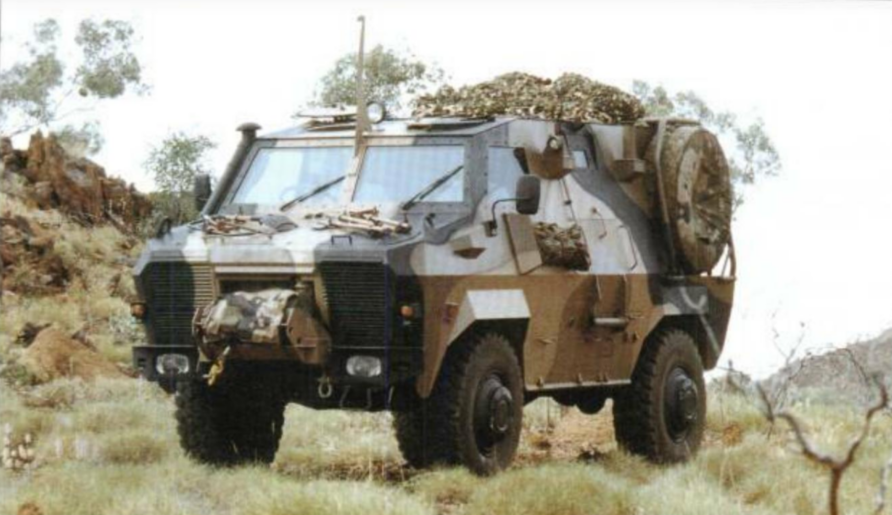
The BAE Foxhound was based on the Shorts Brothers S600 Shorland vehicle, a departure from their normal Land Rover derived designs, instead, using the Unimog U2150L. With a maximum weight of 12.50 tonnes, the Foxhound could carry nine passengers.
By the end of 1996, Transfield and Westrac withdrew, leaving BAE Australia, ANI and Perry Engineering.
The original Perry Engineering concept was based on the Timony Technology MP44 vehicle that made extensive use of the automotive components from the Stewart and Stevenson Family of Medium Tactical Vehicle (FMTV).
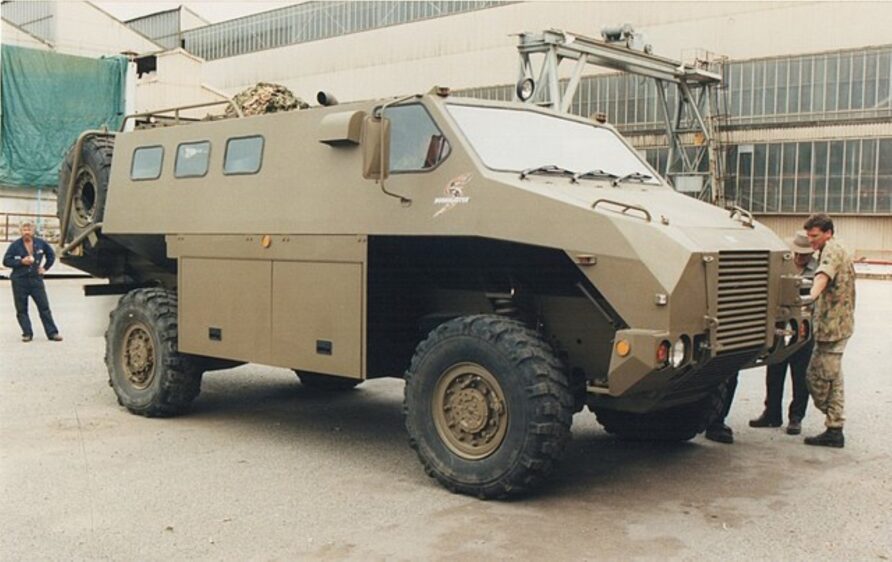
Of the three, it had the highest weight, at 14 tonnes, but the monocoque chassis, not a conventional truck chassis like the others, provided several protection benefits.
There was also a growth path to a 6×6 variant, the MP66 (shown below in a later prototype)

Phase 2B was the Request for Tender process, Phase 3, manufacture and introduction to service.
BAE then withdrew, leaving just Perry Engineering and ASVS.
During the trials, Australian Defence Industries (ADI) purchased the rights to the Perry Engineering vehicle as proposed for Project Bushmaster and redesigned much of it (especially the hull) to ensure compliance with the ADI requirements.
ADI claimed their vehicle could withstand a 19 kg explosive charge under any wheel.

Neither of the vehicles actually met requirements, especially on reliability.
Trials were completed at the end of 1998 and in March 1999, the Australian Minister for Defence announced that the ADI Bushmaster was the winner.

Initial quantities were to be 352 (352 for the Army and 18 for the RAAF) to be in service by 2002, although additional variants were planned.
A pair of early models were modified and sent to East Timor in 1999, serving as VIP transport vehicles.

ADI was privatised in November 1999 with 50% each owned by Transfield (one of the original losing bidders) and Thomson CSF.
It would be unfair to characterise the Bushranger project as a total success, the winning vehicle took much longer to bring into service than planned and was certainly pricier, this from an Australian tabloid:
The Australian Defence Force’s much-anticipated Project Bushranger appears set, like Ned Kelly himself, for a gruesome ending. The project, to build more than 300 landmine-protected infantry vehicles, is massively over budget and ridiculously behind schedule. Our defence forces have run out of patience, giving the manufacturers until the end of the year to sort the mess out.
A 2004 Sydney Morning Herald story in 2004 summed up the situation:
The army’s new Bushmaster troop carrier sums up what can go wrong with defence purchases. The prototype vehicles were 10 times less reliable than the army wanted. But the army bought them anyway because the only alternative was 20 times less reliable. The original cost was supposed to be $170 million for 370 vehicles. In the end, taxpayers will get 299 vehicles for $329 million. And though taxpayers’ money has been used to develop the vehicles, the army has no patent over any part of the project and no royalty agreement with ADI if the company sells the vehicles overseas. Now that the wrinkles have been ironed out using taxpayer money, that looks likely
However, by 2004/2005, the Australian Army had a workable and effective medium protected mobility vehicle, and one that has gone on to be exported well and obtained in larger numbers, including some to the British Army.
Transfield was purchased by Thales in 2006 and ADI was renamed Thales Australia.
Over one thousand Bushmaster vehicles have been ordered by the Australian Defence Force, it has been exported to the Netherlands, Fiji, Indonesia, Jamaica, Japan, New Zealand, and Ukraine.
In Indonesia Bushmaster vehicles are known as Sanca, made by Pindad.
Before reading on, would you mind if I brought this to your attention?
Think Defence is a hobby, a serious hobby, but a hobby nonetheless.
I want to avoid charging for content, but hosting fees, software subscriptions and other services add up, so to help me keep the show on the road, I ask that you support the site in any way you can. It is hugely appreciated.
Advertising
You might see Google adverts depending on where you are on the site, please click one if it interests you. I know they can be annoying, but they are the one thing that returns the most.
Make a Donation
Donations can be made at a third-party site called Ko_fi.

Think Defence Merch
Everything from a Brimstone sticker to a Bailey Bridge duvet cover, pop over to the Think Defence Merchandise Store at Red Bubble.
Some might be marked as ‘mature content’ because it is a firearm!
Affiliate Links
Amazon and the occasional product link might appear in the content, you know the drill, I get a small cut if you go on to make a purchase
UK Bushmaster Use
Anecdotally, the United Kingdom Special Forces favoured the Pandur 2 6×6 vehicle, as per the US Armoured Ground Mobility System (AGMS).

But, to meet the demanding timescale for delivery and specifications, the Bushmaster was selected as part of the Escapade programme and 24 vehicles obtained, seeing service in the Middle East.
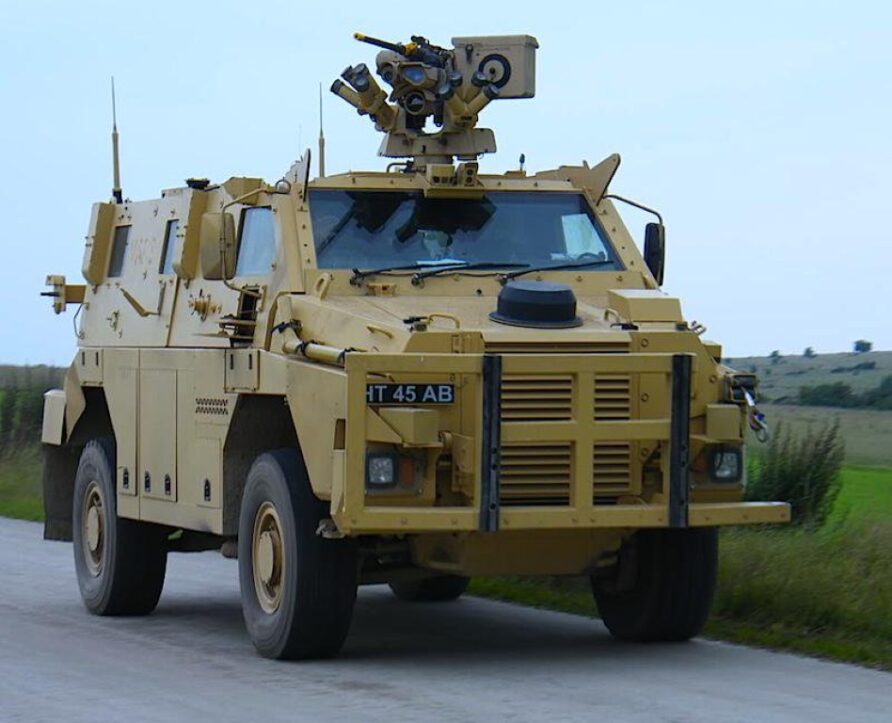
Bushmaster was also pitched at the Operational Utility Vehicle System (OUVS) programme, that was ultimately cancelled.
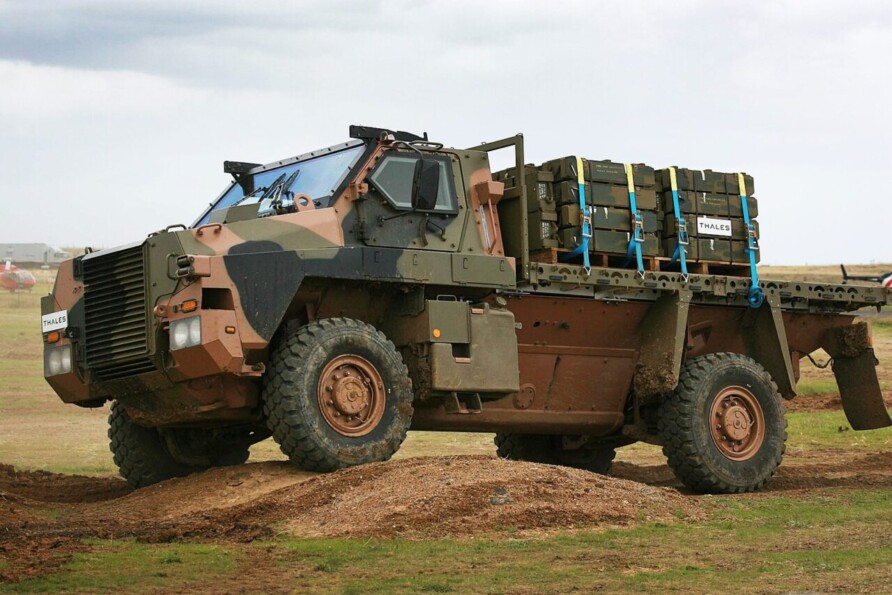
In early 2018, Thales unveiled the Bushmaster MR6 variant, an upgraded vehicle with a host of improvements including a new Euro 3 compliant engine, protection, and electronics.
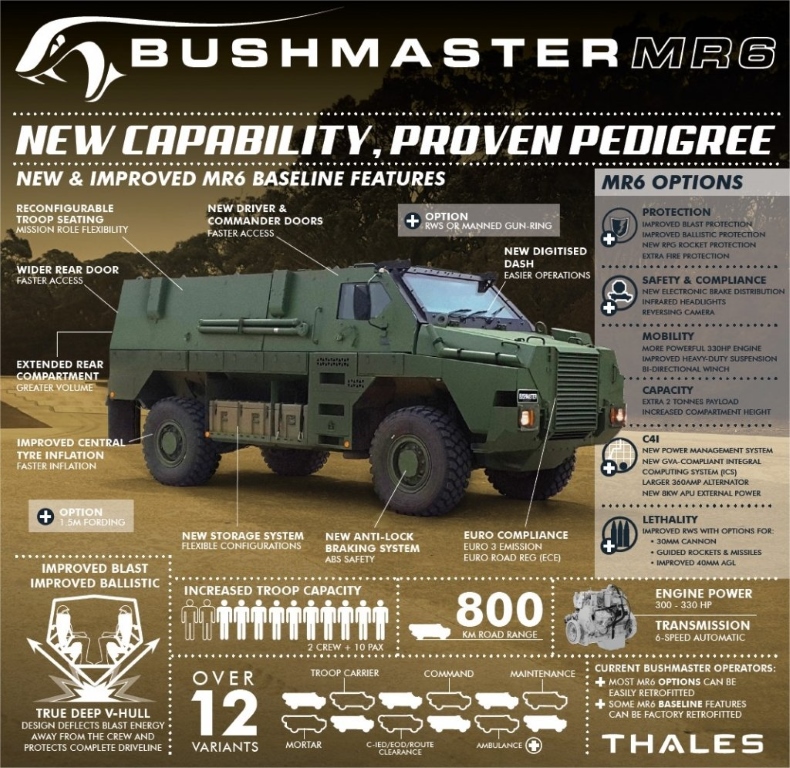
The MR6 was aimed at the then Multi Role Vehicle — Protected (MRV-P) programme, also cancelled.

The New Zealand standard, is the most recent.
Bushmaster has also been offered to the UK to meet the requirements of the Land Mobility Programme (LMP).
Vehicle Information
The Bushmaster has a kerb weight of approximately 12 tonnes depending upon the variant, is 7.2m long, 2.48m wide and 2.65m high (without RWS).
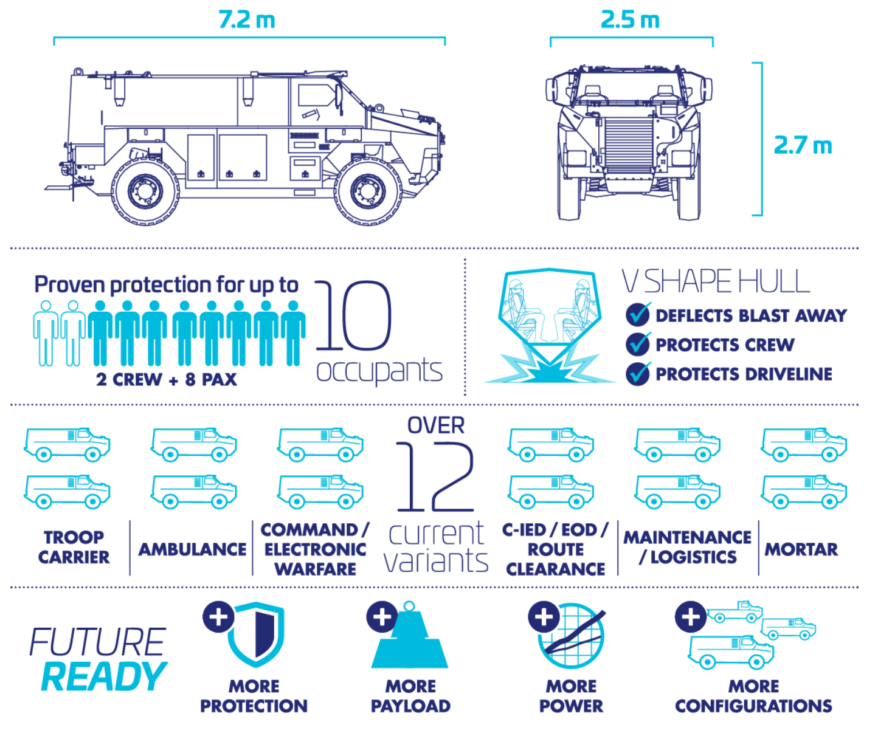
Bushmaster has proven to be a robust, reliable and very well-protected vehicle, with operational experience gained from deployments to Iraq, Afghanistan, and East Timor.

The Troop variant has seats for 2+10 and other variants include Command, Mortar Carrier, Ambulance, and Repair Fitter.
Other variants have been proposed, such as single and double cab cargo, and electronic warfare, but not yet entered service.
Read more at Thales
EOD variant.

ECM variant

Thales has also completed some initial concept work on a 6×6 variant.
A version equipped with the Kongsberg Naval Strike Missile has also been demonstrated, called the Strikemaster

Read more (Affiliate Link)
Discover more from Think Defence
Subscribe to get the latest posts sent to your email.



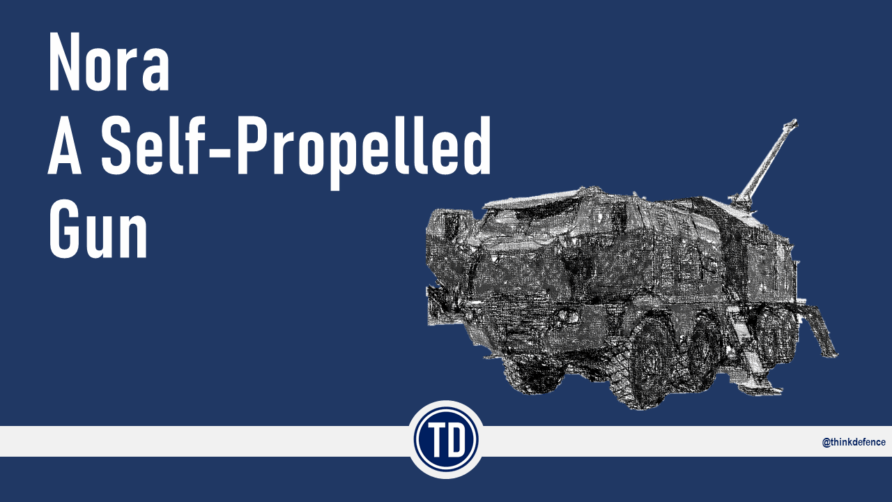
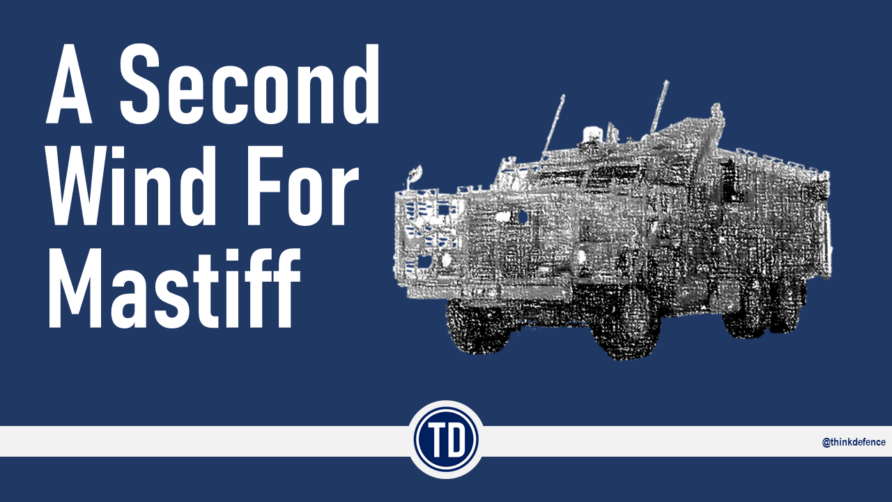
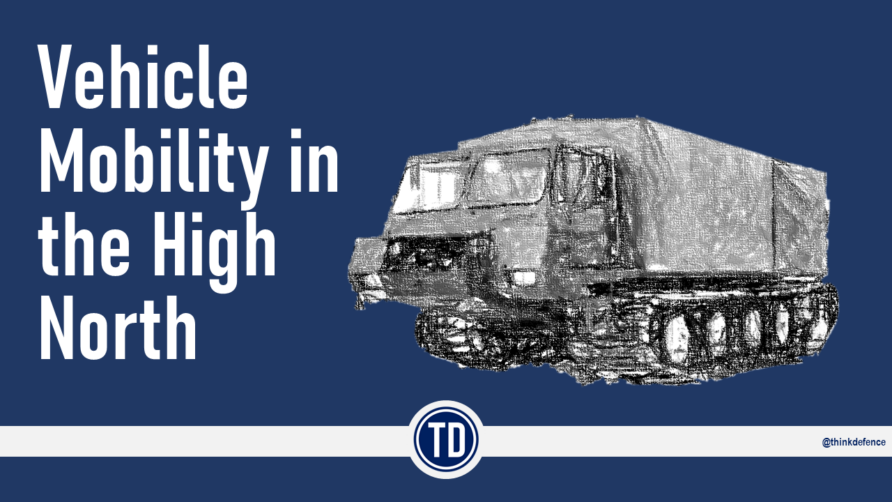
Another great read. Thank you.
Thanks Hugh
So the MR6 was offered for MRV-P with 2 crew plus 10 pax, and as we have run the Phalanx Company project that looked at increasing the infantry section to 10, we are now being offered the NZ “ 5.5 “ version which is only 8 pax? Am I missing something as this appears to make little to no sense?
I hadnt noticed that Jed, maybe the seats are bigger, or there is more stowage space?
FYI TD on You Tube I fell across all 5 parts of the original documentary on the Africar project.
Part 5 with the ever stuck SIII LWB is interesting. Well all of it is interesting really.
Look for the channel Afri Car.
That's Afri Car
A – f -r – i
C -a – r
A South African video from 1999 about Casspir family of vehicles.
https://youtu.be/GD7_rEm8PQA?t=284
TD you need a misc thread so we can post finds!